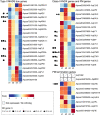Transcriptome profiling and weighted gene co-expression network analysis of early floral development in Aquilegia coerulea
- PMID: 33184405
- PMCID: PMC7665038
- DOI: 10.1038/s41598-020-76750-7
Transcriptome profiling and weighted gene co-expression network analysis of early floral development in Aquilegia coerulea
Abstract
The earliest phases of floral development include a number of crucial processes that lay the foundation for the subsequent morphogenesis of floral organs and success in reproduction. Currently, key transcriptional changes during this developmental window have been characterized in the model species Arabidopsis thaliana, but little is known about how transcriptional dynamics change over the course of these developmental processes in other plant systems. Here, we have conducted the first in-depth transcriptome profiling of early floral development in Aquilegia at four finely dissected developmental stages, with eight biological replicates per stage. Using differential gene expression analysis and weighted gene co-expression network analysis, we identified both crucial genes whose expression changes mark the transitions between developmental stages and hub genes in co-expression modules. Our results support the potential functional conservation of key genes in early floral development that have been identified in other systems, but also reveal a number of previously unknown or overlooked loci that are worthy of further investigation. In addition, our results highlight not only the dynamics of transcriptional regulation during early floral development, but also the potential involvement of the complex, essential networks of small RNA and post-translational regulation to these developmental stages.
Conflict of interest statement
The authors declare no competing interests.
Figures








Similar articles
-
Quantitative live imaging of floral organ initiation and floral meristem termination in Aquilegia.Development. 2022 Feb 15;149(4):dev200256. doi: 10.1242/dev.200256. Epub 2022 Feb 17. Development. 2022. PMID: 35175330
-
Comparative transcriptomics of early petal development across four diverse species of Aquilegia reveal few genes consistently associated with nectar spur development.BMC Genomics. 2019 Aug 22;20(1):668. doi: 10.1186/s12864-019-6002-9. BMC Genomics. 2019. PMID: 31438840 Free PMC article.
-
Conserved roles for Polycomb Repressive Complex 2 in the regulation of lateral organ development in Aquilegia x coerulea 'Origami'.BMC Plant Biol. 2013 Nov 20;13:185. doi: 10.1186/1471-2229-13-185. BMC Plant Biol. 2013. PMID: 24256402 Free PMC article.
-
Understanding the development and evolution of novel floral form in Aquilegia.Curr Opin Plant Biol. 2014 Feb;17:22-7. doi: 10.1016/j.pbi.2013.10.006. Epub 2013 Nov 15. Curr Opin Plant Biol. 2014. PMID: 24507490 Review.
-
Tinkering with transcription factor networks for developmental robustness of Ranunculales flowers.Ann Bot. 2016 Apr;117(5):845-58. doi: 10.1093/aob/mcw037. Epub 2016 Apr 18. Ann Bot. 2016. PMID: 27091506 Free PMC article. Review.
Cited by
-
Starch and Sucrose Metabolism and Plant Hormone Signaling Pathways Play Crucial Roles in Aquilegia Salt Stress Adaption.Int J Mol Sci. 2023 Feb 16;24(4):3948. doi: 10.3390/ijms24043948. Int J Mol Sci. 2023. PMID: 36835360 Free PMC article.
-
Loss of staminodes in Aquilegia jonesii reveals a fading stamen-staminode boundary.Evodevo. 2024 May 25;15(1):6. doi: 10.1186/s13227-024-00225-3. Evodevo. 2024. PMID: 38796457 Free PMC article.
-
X-ray microscopy enables multiscale high-resolution 3D imaging of plant cells, tissues, and organs.Plant Physiol. 2022 Feb 4;188(2):831-845. doi: 10.1093/plphys/kiab405. Plant Physiol. 2022. PMID: 34618094 Free PMC article.
-
Genetic architecture underlying variation in floral meristem termination in Aquilegia.J Exp Bot. 2022 Oct 18;73(18):6241-6254. doi: 10.1093/jxb/erac277. J Exp Bot. 2022. PMID: 35731618 Free PMC article.
References
Publication types
MeSH terms
Substances
LinkOut - more resources
Full Text Sources
Molecular Biology Databases

